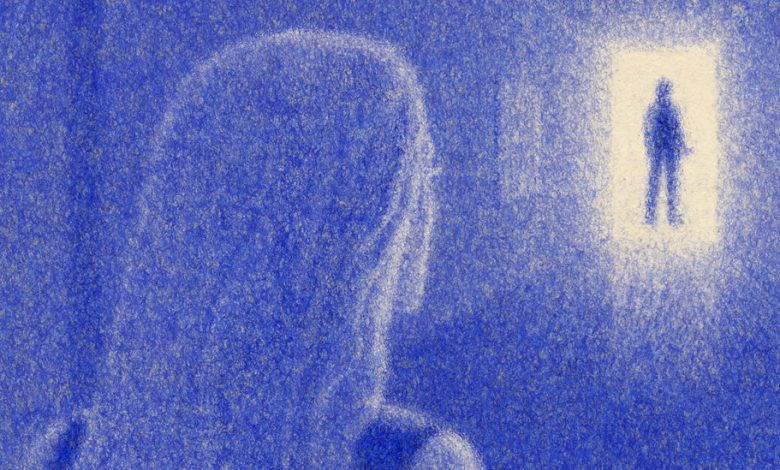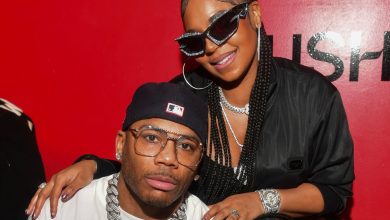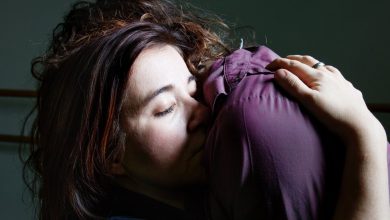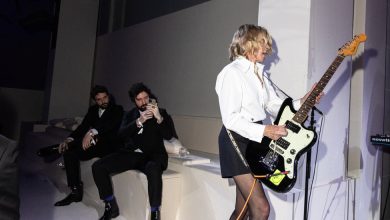Yes, Shaun Cassidy Is Still Dreamy

I was approaching the George Washington Bridge when my friend Lynn fired a text into the Shaun Squad group chat: “GET READY, PARTY PEOPLE!”
My heart sank as the message piped through the car speakers in a robotic female voice.
I dictated back: “OMG, Lynn, you better not be about to text something that’s going make me regret that I didn’t get my brows waxed for tonight.”
“I am,” she replied.
A flood of adrenaline sent my pulse racing.
An hour later, I would be face to face with my original schoolgirl crush, Shaun Cassidy. Unruly eyebrows and all.
In the late ’70s, thanks to the one-two punch of his starring role in ABC’s teen detective series “The Hardy Boys” and a run of hit singles, he was regularly on the cover of Tiger Beat and other teen magazines. His look — feathered hair, satin baseball jackets and skintight pants — launched a tsunami of adolescent hormones.
Long before “nepo baby” was a thing, he rose to fame as the firstborn son of the musical star turned “Partridge Family” matriarch Shirley Jones and the Broadway legend Jack Cassidy. His half brother, David Cassidy, had preceded him in teen dream stature.
Shaun’s most popular single was his cover of the Crystals’ “Da Do Ron Ron,” but my favorite was “That’s Rock ’n’ Roll,” a solid bop written by Eric Carmen. Centered on a narrator who’s 16 and sick of school, the lyrics preach the gospel of rock rebellion, and even in my grade school years, the song stuck.
Each of his albums came with a poster — the record label knew its market — and my friend Kristin and I pretended to kiss him until we dissolved into giggles.
As I marched into teendom, I moved from roller skates to combat boots, and my crushes took a more androgynous turn. MTV introduced a slew of British sad boys with teased hair and makeup, the most famous on American shores being Depeche Mode and the Cure. Their subtly subversive masculinity so besotted me that my real-life male contemporaries were a letdown. A memoir of my romantic coming-of-age could be titled “I Was Told There Would Be Eyeliner.”
Then I saw Catherine Deneuve as the nightclubbing vampiress Miriam Blaylock in “The Hunger.” Kissing Shaun’s poster gave way to kissing a shy Goth girl under the poster for the film on her bedroom wall. But you never forget your first, and Shaun, with his faunlike visage, was the perfect gateway crush.
I fell for him the second time because of the rats.
Two years ago, one of his tweets appeared in my timeline. It showed a screen grab of a text from his wife asking him to talk with her about their “rat problem.” Shaun gave it a caption: “She is such a romantic.”
Former teen idol turned Wife Guy? Sure, I’d follow that. Four of my friends also started following him on Twitter, and the Shaun Squad was born.
So when the New York engagement of his “Magic of a Midnight Sky” solo show was announced, one Squad member, Joy, bought tickets the minute they went on sale, and Lynn contacted his tour manager, vowing to arrange a meet-and-greet.
Not likely, I thought. But the girl in me held fast to the fantasy.
As the club filled on the night of the show, our hopes for a meeting began to fade. Monica had a fresh keratin treatment, her hair a glossy curtain. Marjorie had found some old iron-on transfer paper and whipped up her own Shaun tank top. She even made us Swiftie-style “Shaun Squad” friendship bracelets. We were sighing dejectedly into our $18 cocktails when the tour manager appeared.
“OK, let’s go,” she said. “But we’ve got to be quick.”
We moved past the audience of women clutching vintage Shaun memorabilia. I noticed that one of them had brought her “Hardy Boys” lunch box.
Up an elevator and down a narrow hall to the dressing room. And there he was — tall, his hair a mix of blond and gray, the shiny disco-era outfit traded for a black button-down and jeans.
Shaun Freakin’ Cassidy, OK?
I’m enough of an extrovert that I will go into a convenience store to buy chips and, five minutes later, end up saying, “What’s your Instagram?” to the clerk. But not now.
Not now at all.
I let my fellow Shaun Squad members go first, watching them angle in for photos and autographs while he chatted with them, the basso profundo of his speaking voice a pleasing rumble.
Then there was nothing to do but move forward. I was like: “Why is he opening his arms? What is happening? Are we hugging? We are hugging!”
It wasn’t a crazy hug — a quick companionable embrace, followed by that 1-2-3 closure pat — but it produced enough dopamine to make me unable to feel my face for the rest of the night.
The show, even without a fan’s forgiving grading curve, was excellent, a mix of song and story. Given the heedlessness of 1970s celebrity culture, it’s a wonder that Shaun was able to survive the reverse panopticon of teen stardom.
Tactful but candid, he talked about female fans tearing out chunks of his hair and his dad joking about putting his childhood bedroom up for rent when it seemed his son’s fame might eclipse his own. He also included a touching tribute to David, who died of liver failure at age 67 in 2017.
Shaun made it clear that he wasn’t coasting on the fumes of his former glory, having segued from teen idol to television writer and producer. Yet he seemed comfortable enough with his cultural footprint that, in his side hustle as a vintner, his wine is branded My First Crush.
Writing about a fangirl crush can make you feel like a goober, because it elicits contempt that is explicitly gendered. Female fandom — especially Top 40 fandom — carries a processed-cheese sheen. But a guy going on for an hour about a Bruce Springsteen chord progression or a Wilco set list? That’s depth, man. (And queer fandom? Big heteroblivious shrug.)
But fandom cuts across all demographics, and everyone’s deserves respect. One of my favorite viral videos of recent years shows a subway car full of New Yorkers singing the Backstreet Boys’ “I Want It That Way” in unselfconscious joy. We should not be pressured to be so mature in our tastes that we miss all the fun.
In the Fugazi song “Bad Mouth,” the punk stalwart Ian MacKaye sang: “You can’t be what you were. So you better start being just what you are.” As a younger woman, I adopted those lines as a cri de coeur, taken by the hard stance against nostalgia and sentimentality. But I have since reconsidered.
I drove home from the show listening to “That’s Rock ’n’ Roll” on repeat, knowing that a number of my friends were seeing the Cure that same night, my Gen X gloomster cohort having their own flashback moment. And I salute them.
Nostalgia can be a blinkering agent, but it can also be a benevolent time lord, allowing who you were and who you are to join hands. Through the alchemical magic of fandom, you can occupy both phases of your life at once — sensible adult and keening fangirl. Steady sun and hormonal supernova, all of it just a song’s play away.
That’s the crush spirit. That’s nostalgia. That’s rock ’n’ roll.
Lily Burana is the author of “Grace for Amateurs: Field Notes on a Journey Back to Faith” and three other books.



